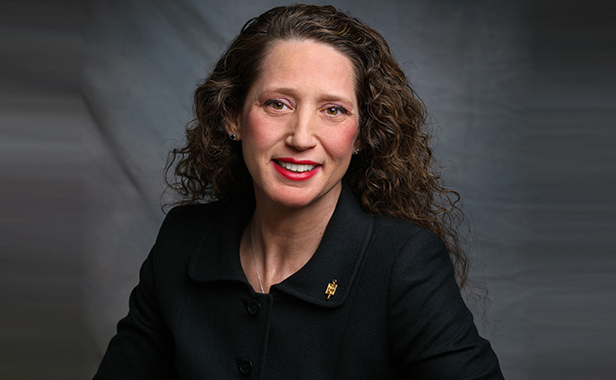 "We talked to every single tenant that wanted some kind of deferment or needed some help," says IREM Chicago president Angela Aeschliman, "and we coordinated with them to pay in stages."
"We talked to every single tenant that wanted some kind of deferment or needed some help," says IREM Chicago president Angela Aeschliman, "and we coordinated with them to pay in stages."
Since the outbreak of the COVID-19 pandemic, property managers have faced the challenges of maintaining productivity, while ensuring the health and safety of their employees and occupants.
And now that the nation is pivoting to a full back-to-work strategy, property managers are strategizing right along with them. Angela Aeschliman, CPM, senior vice president for the Chicago-based Missner Group, tells GlobeSt.com that consistent communication with her tenants has made navigating these strange waters much easier.
"We've been in touch with our tenants across the board," she says, both to gauge the needs of tenants in the 1.2 million square feet of commercial space she manages, and to keep them apprised of Missner's COVID-19 efforts. "A good 80 percent of our portfolio is working remotely," she says. That's primarily in the office and medical office facilities in the Missner portfolio. The remaining 20 percent is industrial.
Ongoing communication was critical at the outset of the pandemic as Missner tried to assess who could keep up with rent payments, and which tenants would seek deferrals. "In April, we talked to every single tenant that wanted some kind of deferment or needed help," she says, "and we coordinated with them to pay in stages." Since then, the number of tenants asking for relief has actually decreased.
But the communication continues as those tenants – and Missner itself – pivots toward getting back to work. "We're communicating constantly and eliciting their thoughts on getting back to work, because that will drive how we manage our contract services."
Her outreach revealed that many tenants are planning a phased approach to staffing. "Some are planning to bring back 20 percent of their workers," she says. Other tenants are opting for a staggered schedule, with some employees working Mondays, Wednesdays and Fridays, while others take Tuesdays and Thursdays. To add relief to the schedule in the summer months, many offices will close on Fridays.
Aeschliman sees the re-entry project in three pieces. "The first priority is to define all the physical touchpoints and how we can overcome fear of contamination," she explains.
Short of new guidance from the Centers for Disease Control on the lower risk found on touchpoints, the need is still there to question issues like hand sanitizing stations. "We don't have touchless elevators, so when someone arrives at a floor, should we have sanitizers there? Meanwhile, we have to move furniture in the common areas, and enforce stringent restrictions on conference room reservations."
Part of this effort includes reworking the janitorial routine. "Our janitorial scope is going to change," she says. "We may want our night janitors to be in the building in the daytime, because optically this gives our tenants a better sense that we're on top of this."
Those optics are key to the communication process to assure tenants that, beyond words, all is being done to protect their health and safety. While janitors will be more visible during the day, Missner is also considering tent cards placed around the building to alert tenants to cleaning and maintenance that continues through the night. "For their comfort and understanding, it's key to educate tenants on such issues as the scope of work that a true and thorough sanitization takes," she says.
The second tier is to determine, "how we can assist our tenants as they re-occupy," she says. This is especially true of Missner's medical office tenants, who may require sanitation over and above the norm. "Do they need deep cleaning, or do they need the space fogged?" asks Aeschliman, who is also IREM's Chicago chapter president. "Those conversations are taking place as we gear up to opening." (She adds that medical office tenants are down in their patient counts by as much as 30 percent.)
IREM, of course, has been supporting members with guidance throughout the pandemic, much of which members can share with their stakeholders. Now, as the topic turns to re-entry, Aeschliman says she's shared checklists for re-opening from a variety of official sources, such as Environmental Protection Agency guidance on indoor air quality.
The third piece of the puzzle is the creation of protocols for Missner's in-house and vendor teams. To that extent, "we're facing the same challenges as our tenants," she says.
Missner is rearranging workstations and moving teams from one building to another, to facilitate social distancing. Much like Missner's tenants, new shifts and staggered schedules are also being created. Needless to say, personal protective equipment (PPE) is de rigueur, and if someone has a sniffle, "you stay home."
"We even go to the granular level," Aeschliman says, "down to sharing pens and other little habits."
Technology figures heavily into this overall strategy, and Missner has been pushing toward a paperless environment for a number of years now. "We're fairly paperless, but not totally," she says, adding that the firm is constantly moving toward such capabilities via cloud-based work orders and accounts payable and receivable – a major help today for tracking the above-mentioned rent deferrals.
But technology without communication does little for the tenant/property manager partnership. "We remind our tenants that we're right here, behind that work order, which can be immediately dispatched to our vendors," she says.
Technology, new protocols and emphasis on communication are all part of the partnership that exists between property manager and tenant, Aeschliman says. "These are the sort of opportunities we seek to make operations even better."
© Touchpoint Markets, All Rights Reserved. Request academic re-use from www.copyright.com. All other uses, submit a request to [email protected]. For more inforrmation visit Asset & Logo Licensing.







